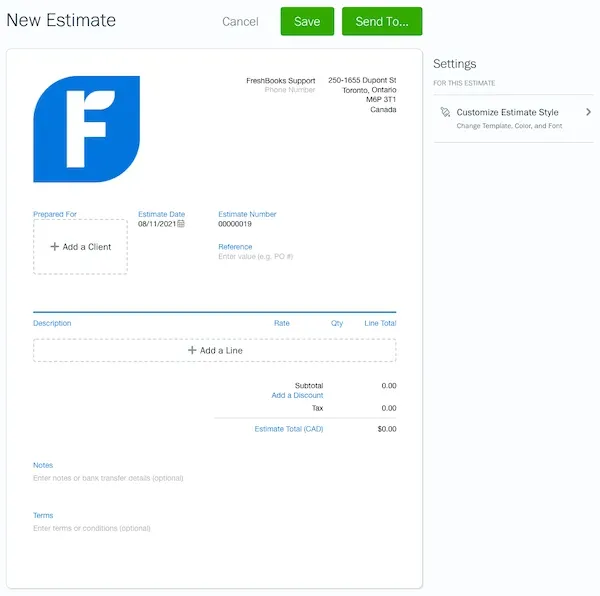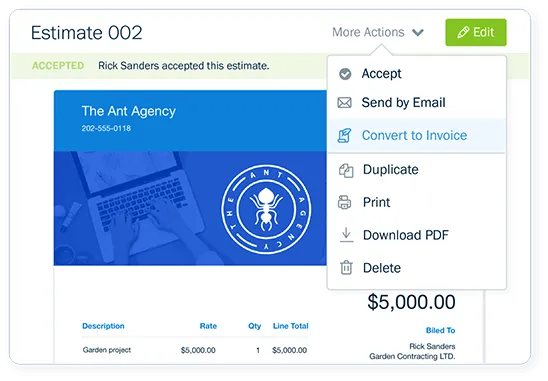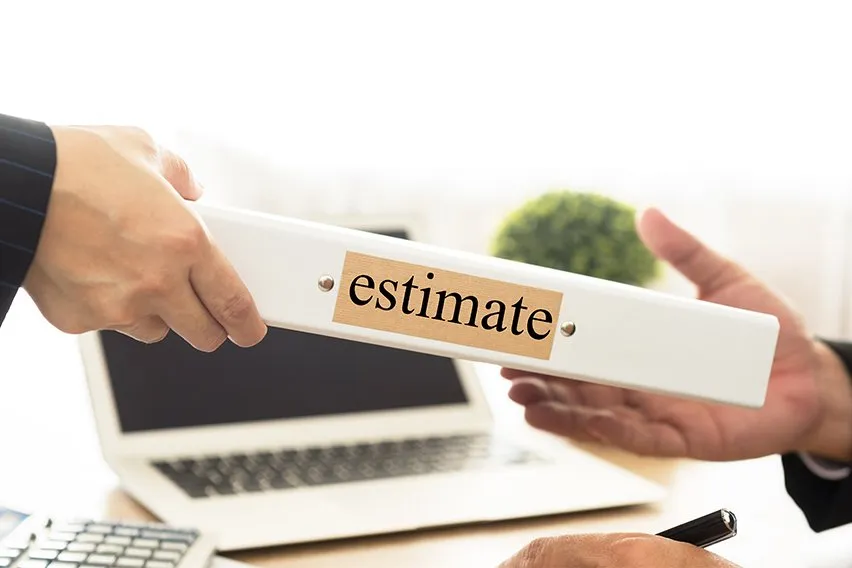How To Bid A Paint Job: A Complete Estimation and Bidding Guide

Submitting a bid for a painting job can be a tough challenge if you’re a painting company. You don’t want to put your bid in too high if it gets rejected. But you also don’t want to come in too low. You want your bid to reflect the quality and professionalism of your work with a good profit margin.
But how do you balance between not going too high or too low? The good news is that there are some things that you can take into consideration. Your odds of having your bid accepted can increase and you can make sure you receive the right amount of compensation for your painting business.
Here is everything you need to know to bid for a paint job.
Key Takeaways
- Preparation is key. The more information you gather about the job and the site, the easier it will be to formulate an estimate that’s good for you and your customer.
- You must determine all your costs and add them to your estimate to accurately reflect what you’ll charge.
- Many costs are associated with developing an estimate, it’s not just materials and labor.
- Don’t forget about markup. Determining what you want to profit from the job is an important part of your estimate.
- Using a template can help you so you don’t miss out on any hidden costs and can have an accurate estimate that suits both you and your customer.
Here’s What We’ll Cover:
Things to Keep In Mind Before You Get Started
Determine Your Material and Labor Costs
Determine Equipment and Rental Costs
How to Determine the Final Estimate
Bidding for a Paint Job Estimate Template
Leverage Software for Paint Job Estimates
Things to Keep In Mind Before You Get Started
Some paint jobs can be quick and easy, and others can be much more time-consuming and tedious. Knowing some of these variables can help make your bid estimate more accurate. Things like how much preparation work you will have to do, how long it will take to paint, and your total materials cost.
There can be other things to consider as well. Like how difficult the paint job is, any time constraints to finish the job or any other specialty materials you might require. Knowing these details will allow you to develop a more accurate estimate.

There can be other things to consider as well. Like how difficult the paint job is, any time constraints to finish the job, or any other specialty materials you might require. Knowing these details will allow you to develop a more accurate estimate

Visit the Site
Whether you’re estimating a residential job or a commercial painting job, visiting the site where the paint job will get done can be one of the best things you can do. You will be able to see the entire space and account for any other factors that can affect your ability to do the job. Finding the square footage can help determine the amount of paint you need or if you require additional materials.
To figure out how much square footage you need to cover for the painting project, you can simply multiply the width of a wall by its height. To make this as easy as possible, break down your square footage calculations on a wall-by-wall or room-by-room basis. You can then add the different square footage together to get the total square footage.
Determine Your Material and Labor Costs
Are you bidding on a really big job? Or is it a smaller job? Is it a commercial paint job? Are you going to need to hire extra contractors or additional labor to help you complete the work? How much paint do you need? How much does the customer’s requested paint cost? There are several factors to take into account depending on the demands of the project and the cost of supplies.
Common materials to factor into your commercial painting bids:
- The amount of paint needed
- Masking tape or painter’s tape
- Paint rollers
- Paint trays
- Drop cloths
- Different types of caulking
- Primer if needed
- Ladders
Common labor costs to factor into your painting bids:
- How many workers do you need to complete the job if you can’t do it on your own
- The amount of prep time or work needed
- This could include things like removing old windows, fixing wood damage, removing vegetation, or scraping old paint off.
- The amount of time to complete the job
Labor costs can be difficult to estimate accurately. But it’s always better to account for more instead of less. This way, you can avoid delays or work stoppages if you don’t account for enough labor to finish the job.
Determine the Type of Paint
What colors are needed? Is there a specific type of paint that the client wants? Is it an exterior painting or an interior paint job? What’s actually getting painted? How many gallons?
Knowing the answers to these questions will help you develop an accurate estimate and be able to budget accordingly. You will not only find out exactly which areas need to get painted, but you will also find out if any trim, doors, or ceilings also need to get painted.
It typically takes around a gallon of paint to be able to fully cover 400 square feet of surface area. So, if you determine the area to be 375 square feet, then one gallon of paint would be enough. However, the type and overall quality of the paint can impact the surface area it will cover. You will need more paint for a second coat.
Discuss some of your options at your local paint store. They can provide more information on the differences in types of paints.

Determine Equipment and Rental Costs
One important factor in making effective commercial painting estimates is determining as many of your costs and expenses beforehand as you can. Equipment and rental costs can factor heavily in each estimate and impact your total price for your customer and your final net profit. Always check to see if you need additional equipment to complete the job. Do you have a tall enough ladder for a commercial property? Will you need a burlap or plastic tarp to provide outdoor vegetation coverage to protect plants from spills for exterior paint jobs? If you are hiring extra employees, do you need to rent equipment for them to use? The most experienced painter knows that preparation saves money.
Determine Markup
Remember to factor in markup and profit to your estimate. To simplify this, you can use a markup calculator to help determine the ideal profit margin for your painting projects. You can decide how much of a markup you’d like to charge and calculate that on your estimates. How much profit is attainable for the job? Mark-up can be added onto charges for paint, supplies, equipment, labor, overhead, and marketing costs.
Determine Marketing Costs
Word-of-mouth advertising is fantastic but initially, it’s important to get your name out there to get your first clients. Marketing costs can include developing websites, internet ads on social media, getting door hangers printed, door-to-door sales, and of course, traditional advertising. Some companies will offer new customer deals such as free estimates or ‘paint one room get one free.’
Don’t Forget Insurance Costs
Every professional painter knows that even the best plans can go awry, even with an experienced crew. It’s important to have business insurance in case the unforeseen happens. While general liability insurance can’t protect your business from accidents and mistakes, it can give you and your customers a level of security and confidence.
How to Determine the Final Estimate
To calculate the final estimate for your bid taking into account all of the above details, just use this formula

Different types of paint jobs are going to require different materials and labor costs. But physically visiting the site and getting a better sense of the size and any obstacles to overcome is a good first start.
You can then use the information you find in your site visit to formulate an accurate bid.
Also Read: How Much Do Painters Charge Per Square Foot
Bidding for a Paint Job Estimate Template
Here is a checklist of how to develop an estimate for a paint job using the information outlined above.
- Visit the site – determine the square footage and overall condition of the areas that need to get painted. Multiply the width by the height to get the square footage of a wall or area.
- Calculate the cost of paint – divide the total square footage that needs to get painted by the surface area that one gallon of paint covers. Let’s say one gallon of paint covers 400 square feet and the job is a total of 1,500 square feet. Four gallons of paint would cover 1,600 square feet, which would be more than enough for your job. You then multiply those paint prices by the price it costs for one gallon. For example, 4 gallons x $25 per gallon = $100.
- Calculate the material costs – anything you need to complete your job. Materials can include things like ladders, tape, paint trays, paint rollers, caulking, or drop cloths, for example. Just add up the cost of the different materials you require.
- Calculate your desired markup – Determine how much profit you require to make the job profitable.
- Calculate the labor costs – there are some areas to consider when calculating labor costs. Things such as a professional painter’s experience or any obstacles that can affect their ability to work efficiently. Hiring the right labor can reduce costs in the long run by avoiding mistakes and delays in completing the job.
- Estimate marketing costs – if you are going to market your services, be sure to account for those costs. Things like online advertising or having marketing materials created should get added to the estimate.
- Determine equipment and rental costs–Do you need any additional equipment for this job? It may make more financial sense to rent equipment that you may not need on a regular basis. Do your research on costs and add these to your estimate. Ask about possible late fees and second-day charges just in case.
- Make sure that you don’t forget insurance costs! Calculate your costs and factor these into your estimate.
Leverage Software for Paint Job Estimates
Successful painting contractors know that preparation and the right tools make any job easier. One tool that can make your estimates easier is a software package that includes estimate support. Just think, it can guide you to a full estimate for your customers and remind you of any points that you may have missed.
FreshBooks full package software offers:
- Estimate support and guidance
- Timesheet tracking for your employees
- Costs and invoicing when the job is done
FreshBooks estimating software can even help you keep track of your projected costs and clients. You can sign up and try the software for free by clicking here.

Conclusion
It can be a daunting and overwhelming process to try and develop an accurate painting bid. You want your estimate to reflect the quality of work you will provide but you also don’t want to bid too low or too high. Knowing exactly what you need to account for from the beginning will help set you up for success.
Visiting the job site will give you a better sense of everything you need to include in your bid. You will be able to see the size of the job and determine if you will need to purchase additional materials or hire extra labor. If you follow a checklist for estimating, like the ones outlined above and those offered in Freshbooks estimating software, you can formulate a professional estimate that could win you multiple residential and commercial painting jobs. The bids you submit will be accurately priced for what is required for the job and will suit your individual business goals and project budget. Click here to sign up for a free FreshBooks trial. You can think of this software like taping and tarp, as important parts of your painting preparation.
Did you enjoy reading this guide? Head over to our estimate category for more great content.
FAQs on How to Bid a Paint Job
How much should I charge for a paint job?
Painting jobs should be charged according to your estimated costs for your time, employees, paint, supplies, mileage, and square footage. A full estimate is important to factor in all your costs so you can generate a net profit.
How do painters calculate square footage?
Painters calculate the square footage of wall space by multiplying the width of a wall by its height. You can do this for each wall in a room and add them together to get the total square footage. To factor in multiple rooms, just add all the walls together.
How much does it cost to paint 1500 ft ²?
Costs for painting a 1500 square foot space depend on many factors, including the type of paint used, material, labor, and time costs.
How many square feet can a painter paint in one day?
How much a professional painter can paint in one day depends on many factors – such as if the prep work is done and the technical difficulty of the job.
How much is a painter per hour?
The cost of a painter per hour depends on their experience and the type of painting work needed. Experienced painters cost more than those new to the job.
Reviewed by
Michelle Alexander is a CPA and implementation consultant for Artificial Intelligence-powered financial risk discovery technology. She has a Master's of Professional Accounting from the University of Saskatchewan, and has worked in external audit compliance and various finance roles for Government and Big 4. In her spare time you’ll find her traveling the world, shopping for antique jewelry, and painting watercolour floral arrangements.
RELATED ARTICLES



 Construction Cost Estimate: Basics, 3 Methods & Templates
Construction Cost Estimate: Basics, 3 Methods & Templates 5 Best Construction Takeoff Software
5 Best Construction Takeoff Software Flooring Estimate and Installation Cost Calculator
Flooring Estimate and Installation Cost Calculator How to Calculate a Building Material Estimate
How to Calculate a Building Material Estimate What Is Construction Takeoff & How to Do It?
What Is Construction Takeoff & How to Do It? Cost Estimation in Project Management: Types & Techniques
Cost Estimation in Project Management: Types & Techniques